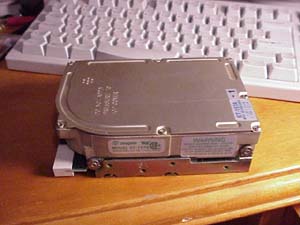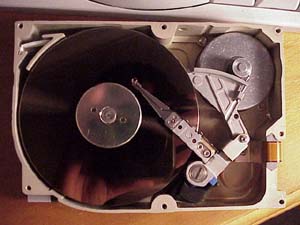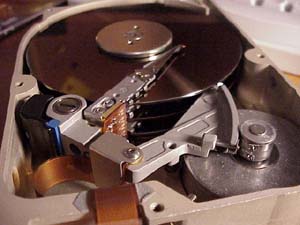Page 1
All images in this article will enlarge when clicked..
This article was inspired by Manaz's IBM 20gb HDD Anatomy, which can be found here. In that article he planned to take an older HDD apart to compare with the more modern drive, but was unable to. So, I have. I won't go into a history of the HDD or what the future holds as he already has.
The HDD in question was the Seagate ST-157A 40MB. Dated 1989 on some of the chips, I thought it was old enough to compare with the IBM and still have a bit of interest. First, I tried to install it on my i440BX board, and found that sure enough, it wasn't going to work. The 124MB drive that was in the same 486/33 as it did work, and XP Pro found it all working perfectly, for about half an hour, when it started to smell and make funny noises.

The disk, a Seagate ST-157A 40mb drive. You can see the large size of the drive compared to more modern drives that have many more times the capacity. The actual technology of HDDs has not changed that much since the days of this drive - they still use the same connectors and still have platters. With IBM's nanotechnology we have seen lately, things may be going to change, but it's not likely for a while. This disk still uses the standard IDE connectors, and the standard molex power plugs.

Unscrewing the cover (with the incorrect screwdrivers, dammit) reveals it to be 'sealed' with a spongy grey substance and to have some holes to compensate for the changing pressure, caused by the heat generated by the spinning platters. To ensure that dust does not get in and contaminate this comparitively clean part of the disk, a dust filter is stuck on with some sort of glue. This filter is no were near as high-tech as the one on the IBM disk, as shown here. The fault line running across the top half of the cover was there when I opened it, but wouldn't interfere with the operating of the disk.

Looking into the drive reveals all the parts usually found in a HDD, but in difference to the IBM 75GXP the disk actuator arms and heads don't come off the platters when the disk is not in use, they stay over them. This means that if the disk was given a reasonable shock, the heads could damage or scratch the platters, ruining them. In this disk however, it never received any in its lifetime.

You can see the four (in the pictures it looks like three, but you'll have to believe me) disk platters, they are big and shiny, just like modern ones. In one of the pictures, you can see me taking the photo, thats how shiny they are.
|


